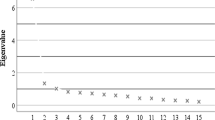Abstract
Contemporary office buildings have primarily adopted environmental sustainability criteria through the guidelines and requirements of domestic or international green building rating systems. These systems incorporate criteria aimed at reducing resource consumption and the building’s impact on the environment into their design, as well as criteria to improve indoor environmental quality (IEQ). However, doubts remain about the ability of green rating systems to guarantee occupant satisfaction with the building and its indoor environment in contrast with their counterparts. This research is based on a field study comparing occupant satisfaction in certified green office buildings with conventional buildings in Chile, from a sample of 176 occupants of green buildings and 175 occupants of buildings (N \(=\) 351). The study included a survey of occupants and the monitoring of thermal conditions in workspaces. The results showed that there are no significant differences in satisfaction and comfort between green buildings and their conventional counterparts. The occupants of conventional buildings showed trends of higher overall satisfaction for the winter and summer months, as well as for winter and summer temperatures. The other criteria, such as air in winter and summer, showed fairly similar results in both building types.
Access this chapter
Tax calculation will be finalised at checkout
Purchases are for personal use only
Similar content being viewed by others
References
Thatcher A, Milner K (2012) The impact of a ‘green’ building on employees’ physical and psychological wellbeing. Work 41:3816–3823. https://doi.org/10.3233/WOR-2012-0683-3816
Loftness V, Hakkinen B, Adan O, Nevalainen A (2007) Elements that contribute to healthy building design. Environ Health Perspect 115:965–970. https://doi.org/10.1289/ehp.8988
Cole RJ, Valdebenito MJ (2013) The importation of building environmental certification systems: international usages of BREEAM and LEED. Build Res Inf 41:662–676. https://doi.org/10.1080/09613218.2013.802115
McArthur J, Powell C (2020) Health and wellness in commercial buildings: systematic review of sustainable building rating systems and alignment with contemporary research. Build Environ 171:106635. https://doi.org/10.1016/j.buildenv.2019.106635
Koponen IK, Asmi A, Keronen P, Puhto K, Kulmala M (2001) Indoor air measurement campaign in Helsinki, Finland 1999 – the effect of outdoor air pollution on indoor air. Atmos Environ 35:1465–1477. https://doi.org/10.1016/S1352-2310(00)00338-1
Altomonte S, Schiavon S (2013) Occupant satisfaction in LEED and non-LEED certified buildings. Build Environ 68:66–76. https://doi.org/10.1016/j.buildenv.2013.06.008
Schiavon S, Altomonte S (2014) Influence of factors unrelated to environmental quality on occupant satisfaction in LEED and non-LEED certified buildings. Build Environ 77:148–159. https://doi.org/10.1016/j.buildenv.2014.03.028
Geng Y, Ji W, Wang Z, Lin B, Zhu Y (2019) A review of operating performance in green buildings: energy use, indoor environmental quality and occupant satisfaction. Energy Build 183:500–514. https://doi.org/10.1016/j.enbuild.2018.11.017
Lee J, Wargocki P, Chan Y, Chen L, Tham K (2019) Indoor environmental quality, occupant satisfaction, and acute building-related health symptoms in green mark-certified compared with non-certified office buildings. Indoor Air 29:112–129. https://doi.org/10.1111/ina.12515
Khoshbakht M, Gou Z, Lu Y, Xie X, Zhang J (2018) Are green buildings more satisfactory? a review of global evidence. Habitat Int 74:57–65. https://doi.org/10.1016/j.habitatint.2018.02.005
Altomonte S, Schiavon S, Kent MG, Brager G (2019) Indoor environmental quality and occupant satisfaction in green-certified buildings. Build Res Inf 47:255–274. https://doi.org/10.1080/09613218.2018.1383715
Steinemann A, Wargocki P, Rismanchi B (2017) Ten questions concerning green buildings and indoor air quality. Build Environ 112:351–358. https://doi.org/10.1016/j.buildenv.2016.11.010
Elnaklah R, Fosas D, Natarajan S (2020) Indoor environment quality and work performance in “green” office buildings in the Middle East. Build Simul 13:1043–1062. https://doi.org/10.1007/s12273-020-0695-1
Gou Z, Prasad D, Lau SSY (2013) Are green buildings more satisfactory and comfortable? Habitat Int 39:156–161. https://doi.org/10.1016/j.habitatint.2012.12.007
Leaman A, Bordass B (2007) Are users more tolerant of “green” buildings? Build Res Inf 35:662–673. https://doi.org/10.1080/09613210701529518
Almeida LM, Tam VWY, Le KN (2020) Quantification of the energy use due to occupant behaviour collected in surveys: a case study of a green and non-green building. J Build Perform Simul 13(6):777–803. https://doi.org/10.1080/19401493.2020.1825529
Zepeda-Gil C, Natarajan S (2020) A review of “green building” regulations, laws, and standards in Latin America. Buildings 10:188. https://doi.org/10.3390/buildings10100188
Bluyssen PM, Roda C, Mandin C, Fossati S, Carrer P, de Kluizenaar Y, Mihucz VG, de Oliveira Fernandes E, Bartzis J (2016) Self-reported health and comfort in ‘modern’ office buildings: first results from the European OFFICAIR study. Indoor Air 26:298–317. https://doi.org/10.1111/ina.12196
Ko WH, Schiavon S, Zhang H, Graham LT, Brager G, Mauss I, Lin YW (2020) The impact of a view from a window on thermal comfort, emotion, and cognitive performance. Build Environ 175:106779. https://doi.org/10.1016/j.buildenv.2020.106779
Acknowledgements
This paper was developed under research projects Fondecyt 1171497 and Fondecyt 1201456. The authors are part of the research group on environmental comfort and energy poverty \(+\)CO-PE, of Universidad del Bío-Bío, Chile.
Author information
Authors and Affiliations
Corresponding author
Editor information
Editors and Affiliations
Rights and permissions
Copyright information
© 2023 The Author(s), under exclusive license to Springer Nature Switzerland AG
About this chapter
Cite this chapter
Trebilcock-Kelly, M., Castro, F., Wegertseder-Martínez, P., Soto-Muñoz, J., Ramírez-Vielma, R. (2023). Occupant Satisfaction with Certified Green Office Buildings in Chile. In: Marín-Restrepo, L., Pérez-Fargallo, A., Piderit-Moreno, M.B., Trebilcock-Kelly, M., Wegertseder-Martínez, P. (eds) Removing Barriers to Environmental Comfort in the Global South. Green Energy and Technology. Springer, Cham. https://doi.org/10.1007/978-3-031-24208-3_7
Download citation
DOI: https://doi.org/10.1007/978-3-031-24208-3_7
Published:
Publisher Name: Springer, Cham
Print ISBN: 978-3-031-24207-6
Online ISBN: 978-3-031-24208-3
eBook Packages: EnergyEnergy (R0)




